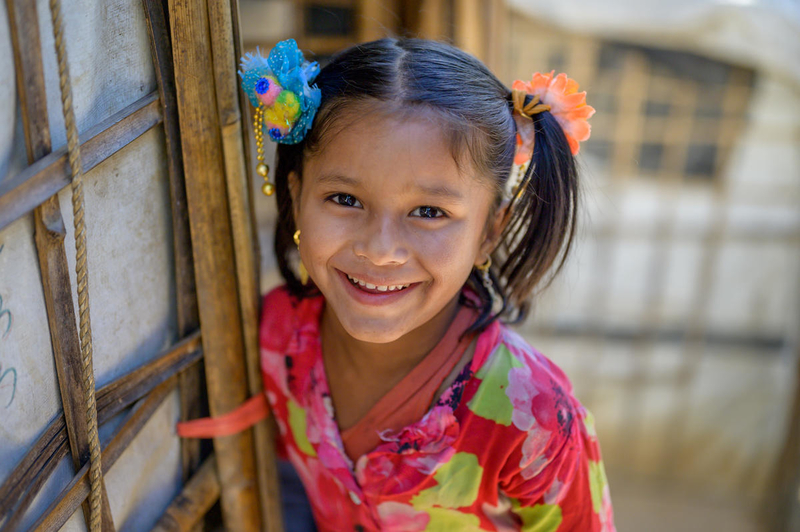“Could your country pray that we would have peace in Myanmar?”
— Salima, Rohingya refugee in Bangladesh
Original story by Kari Costanza, World Vision U.S.
Five-year-old Jannatul enjoys attending a World Vision Child-Friendly Space where she lives in the Cox’s Bazar refugee camp in southern Bangladesh. For her, the Child-Friendly Space is a source of stability in an unpredictable world. Her regular attendance and sunny smile make her a favorite with the World Vision staff.
“She is a bit different,” says Farjana, one of Jannatul’s teachers. “She attends the Child-Friendly Space every day. She concentrates on her studies. When I teach them something, she follows me carefully.”

Jannatul and her mother Salima* are the only two left of their family. Salima’s husband and two of her three children were killed in the violence against the Muslim-minority Rohingya in September 2017. The family became separated when shooting started in their village.
“Jannatul was with me, but I didn’t know what had happened to my husband and my children,” Salima says. “Later I saw them dead.” Mohamed, 30, was shot; their son, Hafej, 2, and one-year-old daughter, Kalima, stabbed to death.
Salima and Jannatul survived by hiding by a riverbank. In the morning they joined thousands of others and fled on foot to Bangladesh.

World Vision’s work with refugees
As of May 2019, there are more than 900,000 refugees living in refugee camps in Bangladesh — more than 700,000 of those arrived in the second half of 2017, after violence escalated in Myanmar among ethnic groups and Myanmar military forces. Most of the refugees identify as Rohingya, a Muslim minority ethnic group in predominantly Buddhist Myanmar. More than half of the refugees are children.
Cox’s Bazar in Bangladesh is the world’s largest and most densely populated refugee camp. Since the refugee crisis began in September 2017, World Vision has served nearly 265,000 people in Bangladesh. We work to ensure refugees have clean water and sanitation facilities, nutrition support, reliable shelter, and hygiene kits. World Vision Child-Friendly Spaces provide a place for children in refugee camps to feel safe and continue getting an education. It’s vital work — but it’s not a complete solution.
To fully protect vulnerable populations, the world needs a strategy to prevent violence and conflict before it starts. We’re advocating for a proactive solution so that children like Jannatul won’t have to flee their homes.
Life for children in refugee camps
The Child-Friendly Space that Jannatul attends is called Surjoful, or sunflower, and was named by the children who attend every day. Two shifts of children come — about 75 younger children at 9 a.m. and nearly 100 at 11 a.m. for two-hour shifts.
Salima is grateful for the Child-Friendly Space: “Jannatul goes to the Child-Friendly Space. It is important that she gets some kind of education. World Vision people are good and kind to us. For everything, I am grateful.”

When Salima and Jannatul first arrived at the camp, World Vision made sure they had a sturdy home, reinforcing their makeshift shelter with cement, tarps, and bamboo to help protect them from monsoon rains. Salima recently started working with a cash-for-work project run by World Vision in partnership with the World Food Programme. She fills sandbags for construction crews preparing the camp for the upcoming monsoon rains. Rohingya are not allowed to work outside the camp, so the money she earns as a now single mother helps buy food for Jannatul.

Jannatul’s name means heaven. “Heaven is a place where children can play,” says Jannatul. “There are many flowers. Many gardens. Many leaves. There is a big pond of water. Heaven is a place where children can take care of the flowers.”
Salima’s thoughts about heaven are more complicated and rooted in her current situation. “Only God knows if I will go to heaven,” she says. “Heaven is like a good home. Well decorated. With many snacks for the children.”
*Name changed to protect identity.
Want to stay informed about how you can speak out on legislation that affects poverty?
Sign up to receive emails about our issues and learn about easy actions you can take to advocate for the health and well-being of children around the world.
Top photo: Five-year-old Jannatul, the sole-surviving child of Rohingya widow, Salima, carries water back to their home in the Rohingya camps near Cox’s Bazaar, Bangladesh. (©2019 World Vision/photo by Jon Warren)



Please help the poorest of the poor and work to bring lasting peace.
There is so much debate in the USA right now about the right to choose. The debates and arguments divide us, but this issue everyone should shout from the top of your lungs, STOP the violence. I wish people would stand up for life and the right to live. ALL people deserve a chance to enjoy the peace that God provides. The citizens of the USA have a responsibility to help the poor and forgotten people of this world. If you believe in Christ then how can you not believe in life. Call on June, 20th and help your brothers and sisters gain the right to be at peace.